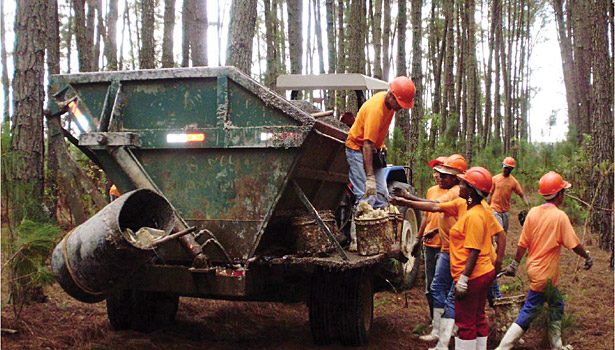Sustainable Success for Adhesives and Sealants through Biorenewable Feedstocks
Innovation and sustainability drive the pine chemicals industry.






For decades, the pine chemicals industry has used biorenewable feedstocks from both forests and factories to produce materials used by a variety of industries, including adhesives and sealants. From the forests, gum oleoresin is collected through the tapping of pine trees and refined into gum rosin and gum turpentine. In factories, crude tall oil (CTO), a mixture of fatty acids, rosin and other bio-materials, is made via the pulping process used by paper mills, and further refined through fractionation.
These substances are used to manufacture adhesives and sealants, as well as paper, paint, printing inks, soap, disinfectants, perfumes, flavors, fragrances and vitamins, to name a few. The gum resin industry is a multi-billion-dollar global business, with more than 1 million metric tons of products produced annually from the sticky substance.
While these forests and factory processes occur in very different environments, they share two important elements: sustainable practices and continued innovation. Why are these two concepts important? Because they have come to the forefront up and down the manufacturing supply chain. Companies are looking for ways to set themselves apart from the competition, and innovation and sustainability are important differentiators.
Seeing the Forest through the Trees
Improved forestry innovation and sustainability were slow in coming, but they have accelerated in the last decade. Tapping pine trees for resin goes back hundreds of years, when it was used for caulking ships and later in chemical intermediates used in manufacturing a multitude of consumer products. Much of this tapping occurred in the southern U.S., where natural pine forests were plentiful. However, a growing and increasingly urbanized population—along with inefficient and unsustainable forest management practices—took its toll, and tapping operations all but disappeared.
Today, pine tapping is done in underdeveloped areas around the globe, as well as in parts of Europe. The collection of oleoresin has traditionally been done through a subsistence-like model: individuals working for themselves in communally owned forests, for low wages, without any mechanization or safety equipment in often difficult terrain.
Until a decade ago, the processes hadn’t changed much from the 1920s and ’30s. Although the gum resin supply was stable, the traditional model was reaching critical mass as gum resin farmers were choosing to leave the forests for better-paying jobs in cities, causing labor shortages. In addition, outdated forestry management practices threatened resin output and, in certain cases, the survival of the forests themselves. These issues motivated key players in the industry to develop new strategies and explore best practices, with the goal of ensuring steady growth and long-term financial health.
Evolving the Business Model
Industry change began to take root, with a concentration on the more efficient use of natural and human resources, the use of genetic engineering, selecting and reproducing high yield and faster growing trees, and improved tapping techniques. Living laboratories—man-made forest plantations—were created in Brazil to test these innovations.
The industry has slowly but steadily moved from a subsistence-like model to an “agribusiness” model. Instead of relying on natural forests, many gum resin companies are buying or leasing land and planting their own plantation forests, with optimal management and productivity in mind. Plantation forest trees are fast growing—six to eight years to reach maturity (compared with 15-20 years in a natural forest)—and can produce up to twice the amount of oleoresin per tree compared to those in native forests.
Pine tappers are now working for companies that run the pine plantations. They receive a competitive salary, as well as safety protective gear and access to standardized equipment. Easily accessed resin collection trucks are replacing heavy buckets that farmers used to carry on their backs for long distances, often through difficult terrain.
Now, one worker can productively tap 7,000-10,000 trees each year, compared to 1,500-2,000 trees tapped in a natural forest annually. The new practices can increase oleoresin yield per hectare by six to seven times that of a native forest, helping to ensure the sustainability of the industry.
Scientific Advancements
As the business model was changing, researchers addressed the trees themselves. Farmers were using tapping techniques dating back to the 1850s. Experiments with new pine tapping methods that require less frequent cutting of the tree have yielded promising results. A new “borehole method” has been found to deliver good yields without the need to frequently “work” the tree. New chemical inducers applied to the tree during tapping—tree hormones, if you will—further stimulate resin output.
Increasing oleoresin output through genetics is another key innovation. Gary Peter, professor of Forest Resources and Conservation at the Genetics Institute in the University of Florida’s Plant Molecular and Cellular Biology program, has developed pine seedlings that have genetic traits correlated with higher resin production. In a study of first-generation genetically bred trees, oleoresin flow was increased 1.4-fold and the number of resin canals within the tree increased 1.1 fold.
The evolving agribusiness model and scientific innovation enables the optimal management of forests, better conditions for workers, and increased productivity and resin output. This ensures steady supplies of gum rosin and gum turpentine while minimizing price fluctuations.
Best Practices in the Factory
Another source of pine chemicals is recovered during the papermaking process, in the form of CTO and crude sulfate turpentine (CST). These products are fractionated to their pure components, including rosin similar to the rosin produced in tapping trees. This industry, which began in the 1940s, has steadily become more efficient due to state-of-the-art best practices adopted in the last several decades.
Manufacturers around the world have developed world-scale, high-efficiency, complex high-temperature and vacuum processes to separate and further process the CTO and CST. These plants are operating with substantially reduced energy and producing high-purity products. This innovation has allowed the industry to stay current with the ever-changing needs of adhesives, ink and papermaking customers.
The value of CTO and CST to customers is further maximized through “cascading,” which is the use of biomass co-products as feedstocks to create another new product. It requires an efficient use of resources throughout the value chain to take advantage of each new product’s co-products in order to create yet another product, until 100% of each co-product’s potential has been harnessed. Only then is the final residue suitable to be converted into energy or disposed of as waste. Without the cascading approach, many bio-friendly chemical solutions would not be available to businesses.
Blueprint for Success
In an October 2013 article, Matt Croson of the Adhesive and Sealant Council detailed trends impacting the industry.1 One of those trends was an increased focus on the practice of green chemistry. Another was sustainability as a market driver in the industry, and the importance of the impact suppliers have on the environment. Improved pine chemicals practices in both forests and factories highlight these trends.
Yet there is always room for improvement. “The pine chemicals industry needs to continually improve its understanding of the best ways to tap gum resin to allow for sustainable growth in the future,” says Alejandro Cunningham, founder of AR Eldorado, a pine resin chemicals consulting company and an expert in pine resin issues. “To do this, we need more industry cooperation and sharing of research and best practices.”
In taking stock of their own innovation and sustainability efforts, and those of their suppliers, adhesives and sealants manufacturers might look to the pine chemicals industry for ideas and inspiration. As a supplier of ingredients that serve as the base of many products, it’s a natural place to start.
For more information, contact the author at (904) 225-5008 or visit www.pinechemicals.org.
Reference
1. Croson, Matt, “5 Trends Impacting the Adhesive and Sealant Industry,” Adhesives & Sealants Industry, October 2013, pp. 12-15.
Looking for a reprint of this article?
From high-res PDFs to custom plaques, order your copy today!





.jpg?height=200&t=1704834340&width=200)


